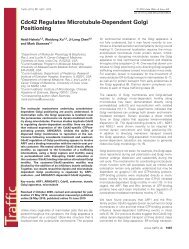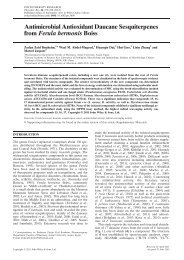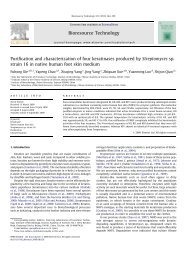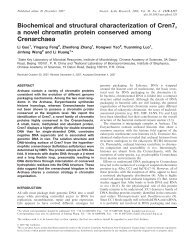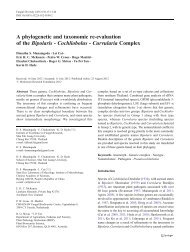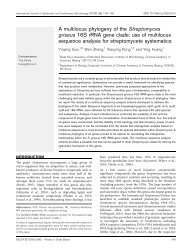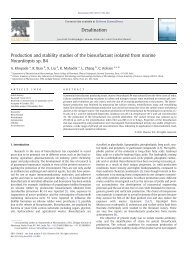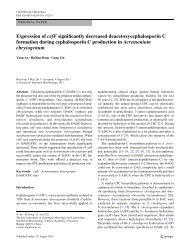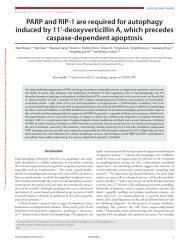Metabolic engineering and flux analysis of Corynebacterium ...
Metabolic engineering and flux analysis of Corynebacterium ...
Metabolic engineering and flux analysis of Corynebacterium ...
You also want an ePaper? Increase the reach of your titles
YUMPU automatically turns print PDFs into web optimized ePapers that Google loves.
SCIENCE CHINA<br />
Life Sciences<br />
• COVER ARTICLE • April 2012 Vol.55 No.4: 283–290<br />
doi: 10.1007/s11427-012-4304-0<br />
<strong>Metabolic</strong> <strong>engineering</strong> <strong>and</strong> <strong>flux</strong> <strong>analysis</strong> <strong>of</strong> <strong>Corynebacterium</strong><br />
glutamicum for L-serine production<br />
LAI ShuJuan 1,2 , ZHANG Yun 1 , LIU ShuWen 1,2 , LIANG Yong 1 , SHANG XiuLing 1,2 ,<br />
CHAI Xin 1,2 & WEN TingYi 1*<br />
1 Department <strong>of</strong> Industrial Microbiology <strong>and</strong> Biotechnology, Institute <strong>of</strong> Microbiology, Chinese Academy <strong>of</strong> Sciences, Beijing 100101, China;<br />
2 Graduate University <strong>of</strong> Chinese Academy <strong>of</strong> Sciences, Beijing 100049, China<br />
Received February 28, 2012; accepted March 19, 2012<br />
L-Serine plays a critical role as a building block for cell growth, <strong>and</strong> thus it is difficult to achieve the direct fermentation <strong>of</strong><br />
L-serine from glucose. In this study, <strong>Corynebacterium</strong> glutamicum ATCC 13032 was engineered de novo by blocking <strong>and</strong> attenuating<br />
the conversion <strong>of</strong> L-serine to pyruvate <strong>and</strong> glycine, releasing the feedback inhibition by L-serine to<br />
3-phosphoglycerate dehydrogenase (PGDH), in combination with the co-expression <strong>of</strong> 3-phosphoglycerate kinase (PGK) <strong>and</strong><br />
feedback-resistant PGDH (PGDH r ). The resulting strain, SER-8, exhibited a lower specific growth rate <strong>and</strong> significant differences<br />
in L-serine levels from Phase I to Phase V as determined for fed-batch fermentation. The intracellular L-serine pool<br />
reached (14.22±1.41) μmol g CDM 1 , which was higher than glycine pool, contrary to fermentation with the wild-type strain.<br />
Furthermore, metabolic <strong>flux</strong> <strong>analysis</strong> demonstrated that the over-expression <strong>of</strong> PGK directed the <strong>flux</strong> <strong>of</strong> the pentose phosphate<br />
pathway (PPP) towards the glycolysis pathway (EMP), <strong>and</strong> the expression <strong>of</strong> PGDH r improved the L-serine biosynthesis<br />
pathway. In addition, the <strong>flux</strong> from L-serine to glycine dropped by 24%, indicating that the deletion <strong>of</strong> the activator GlyR resulted<br />
in down-regulation <strong>of</strong> serine hydroxymethyltransferase (SHMT) expression. Taken together, our findings imply that<br />
L-serine pool management is fundamental for sustaining the viability <strong>of</strong> C. glutamicum, <strong>and</strong> improvement <strong>of</strong> C 1 units generation<br />
by introducing the glycine cleavage system (GCV) to degrade the excessive glycine is a promising target for L-serine production<br />
in C. glutamicum.<br />
<strong>Corynebacterium</strong> glutamicum, L-serine, intracellular metabolites, metabolic <strong>engineering</strong>, elementary mode <strong>analysis</strong><br />
Citation:<br />
Lai S J, Zhang Y, Liu S W, et al. <strong>Metabolic</strong> <strong>engineering</strong> <strong>and</strong> <strong>flux</strong> <strong>analysis</strong> <strong>of</strong> <strong>Corynebacterium</strong> glutamicum for L-serine production. Sci China Life<br />
Sci, 2012, 55: 283–290, doi: 10.1007/s11427-012-4304-0<br />
The amino acid L-serine is one <strong>of</strong> the major components for<br />
nutritional growth <strong>and</strong> development <strong>of</strong> the central nervous<br />
system <strong>of</strong> mammals [1,2], but is also a predominant source<br />
<strong>of</strong> one-carbon (C 1 ) units in de novo biosynthesis <strong>of</strong> purines,<br />
amino acids <strong>and</strong> thymidylate [35] as well as an intermediate<br />
for phospholipid biosynthesis [6] in a variety <strong>of</strong> organisms.<br />
Given its critical role as a building block for cell<br />
growth, the bacterium <strong>Corynebacterium</strong> glutamicum, for<br />
example, has as much as 7.5% <strong>of</strong> its total glucose-originat-<br />
*Corresponding author (email: wenty@im.ac.cn)<br />
ing carbon <strong>flux</strong> distributed to L-serine biosynthesis [7]. In<br />
C. glutamicum, L-serine biosynthesis is initiated from the<br />
glycolytic intermediate 3-phosphoglycerare <strong>and</strong> carried<br />
through three sequential reactions catalyzed by 3-phosphoglycerate<br />
dehydrogenase (PGDH), 3-phosphoserine aminotransferase<br />
(PSAT) <strong>and</strong> 3-phosphoserine phosphatase<br />
(PSP), respectively. PGDH is the gene product <strong>of</strong> serA <strong>and</strong><br />
catalyzes the oxidation <strong>of</strong> 3-phosphoglycerare to generate<br />
3-phosphohydroxypyruvate. PSAT is encoded by serC <strong>and</strong><br />
catalyzes the transamination <strong>of</strong> 3-phosphohydroxypyruvate<br />
to yield 3-phosphoserine. 3-Phophoserine is then dephosp-<br />
© The Author(s) 2012. This article is published with open access at Springerlink.com life.scichina.com www.springer.com/scp
284 Lai S J, et al. Sci China Life Sci April (2012) Vol.55 No.4<br />
horylated to yield L-serine catalyzed by PSP, a gene product<br />
<strong>of</strong> serB (Figure 1). Among the three enzymes, PDGH is<br />
found to be sensitive to feedback inhibition by L-serine <strong>and</strong><br />
only remains 60% activity in the presence <strong>of</strong> 10 mmol L 1<br />
L-serine [8]. It has also been identified that the carboxy-terminal<br />
197 amino acids <strong>of</strong> PGDH are responsible for<br />
the feedback inhibition by L-serine <strong>and</strong> its deletion has only<br />
a minimal effect on the enzyme activity [8].<br />
Catabolism <strong>of</strong> L-serine in C. glutamicum proceeds via<br />
pyruvate in the presence <strong>of</strong> glucose. This conversion reaction<br />
is catalyzed by L-serine dehydratase (L-SerDH) encoded<br />
by the gene sdaA [9]. L-Serine is also used to provide<br />
building blocks for amino acid biosynthesis including glycine,<br />
cysteine <strong>and</strong> tryptophan [911]. Isotope tracer <strong>analysis</strong><br />
demonstrated that the carbon skeleton <strong>of</strong> 13 C-labeled<br />
L-serine is mainly converted to glycine [9]. This reaction is<br />
catalyzed by the gene product <strong>of</strong> glyA, a serine hydroxymethyltransferase<br />
(SHMT) [12]. SHMT catalyzes the reversible,<br />
simultaneous conversion <strong>of</strong> L-serine to glycine <strong>and</strong> tetrahydr<strong>of</strong>olate<br />
to 5,10-methylenetetrahydr<strong>of</strong>olate. Since this<br />
reaction provides the majority <strong>of</strong> the C 1 units needed for cell<br />
growth, disruption <strong>of</strong> the glyA gene is lethal to host cells [12].<br />
A recent study identified that, in the stationary growth<br />
phase, glyA gene expression is tightly controlled by an acti-<br />
vator GlyR at the transcriptional level [13]. This finding<br />
provides a possible regulatory tool to control the <strong>flux</strong> from<br />
L-serine to glycine by manipulating GlyR expression.<br />
At present, the industrial production <strong>of</strong> L-serine mainly<br />
depends on the enzymatic or cellular conversion <strong>of</strong> the substrate<br />
glycine <strong>and</strong> a C 1 compound in the presence <strong>of</strong> an enzyme<br />
system composed <strong>of</strong> SHMT [14]. Many methanol-utilizing<br />
bacteria, such as Hyphomicrobium methylovorum,<br />
have been applied to produce L-serine by using glycine<br />
<strong>and</strong> methanol [15]. These systems either use expensive<br />
substrates or exhibit low productivity that extremely restricts<br />
their application for L-serine production. In addition,<br />
using these industrial strains, large-scale fermentation for<br />
L-serine production is not achieved <strong>and</strong> unlike the production<br />
<strong>of</strong> other amino acids, the conversion <strong>of</strong> cheap sugar to<br />
L-serine is very difficult.<br />
C. glutamicum is amenable to genetic modification <strong>and</strong><br />
shows robust fermentation characteristics using glucose as a<br />
carbon source, hence making it a good c<strong>and</strong>idate to produce<br />
amino acids [16,17]. Subjected to systems metabolic <strong>engineering</strong><br />
in recent years, C. glutamicum has been successfully<br />
applied to produce amino acids including L-lysine, L-valine<br />
<strong>and</strong> L-methionine [1719]. However, the L-serine production<br />
from this bacterium is not yet suitable for industrial<br />
application [20], mainly due to the fact that the metabolic<br />
regulatory systems for intracellular L-serine accumulation<br />
remain largely unknown. In this study, we constructed an<br />
engineered strain SER-8, quantified its extra- <strong>and</strong> intra-cellular<br />
products <strong>and</strong> analyzed its carbon <strong>flux</strong> redistributions<br />
by constructing elementary modes to obtain functional<br />
insights into the performance <strong>of</strong> metabolic networks.<br />
1 Materials <strong>and</strong> methods<br />
1.1 Bacterial strains, plasmids, <strong>and</strong> cell growth<br />
Figure 1 Strategy to engineer C. glutamicum for L-serine production.<br />
Genetic manipulation includes the inactivation <strong>of</strong> the catabolic genes sdaA<br />
<strong>and</strong> glyR (double short lines), the release <strong>of</strong> the feedback inhibition <strong>of</strong><br />
3-phosphoglycerate dehydrogenase (PGDH) by L-serine (dotted long arrow)<br />
<strong>and</strong> the over-expression <strong>of</strong> the biosynthesis genes pgk <strong>and</strong> feedback-resistant<br />
serA r (boldfaced arrows). 1,3-2P-glycerate: 1,3-diphosphoglycerate;<br />
3P-glycerate: 3-phosphoglycerate; P-hydroxypyruvate: phosphohydroxypyruvate;<br />
P-serine: phosphoserine; FH 4 : tetrahydr<strong>of</strong>olate <strong>and</strong> FH 4 =CH 2 :<br />
5,10-methylenetetrahydr<strong>of</strong>olate.<br />
All bacterial strains <strong>and</strong> plasmids used in this study are<br />
listed in Table 1. Luria-Bertani medium was used for E. coli<br />
at 37°C. Brain heart infusion medium was used as a complex<br />
medium for C. glutamicum at 30°C. As a minimal medium,<br />
CGX medium was used with 40 g L 1 glucose [24]. If<br />
necessary, antibiotics were added at the following concentrations:<br />
100 μg mL 1 ampicillin, 50 μg mL 1 kanamycin or<br />
20 μg mL 1 chloramphenicol for E. coli <strong>and</strong> 25 μg mL 1<br />
kanamycin or 10 μg mL 1 chloramphenicol for C. glutamicum.<br />
The strains harboring the plasmid with the P tac promoter<br />
were cultivated with the addition <strong>of</strong> 1 mmol L 1 isopropyl-β-D-thiogalactoside<br />
(IPTG).<br />
1.2 Construction <strong>of</strong> plasmids <strong>and</strong> strains<br />
All genetic modifications were introduced into the C. glutamicum<br />
genome using the homologous sacB recombination<br />
system [25,26]. Gene disruption was performed as described<br />
previously [27]. Correct integration <strong>and</strong> in-frame
Lai S J, et al. Sci China Life Sci April (2012) Vol.55 No.4 285<br />
Table 1<br />
Strains <strong>and</strong> plasmids used in this study<br />
Strains <strong>and</strong> plasmids Relevant characteristics Reference or source<br />
E. coli<br />
DH5α<br />
supE44, φ80 lacZ∆M15, hsdR17, recA1, endA1,<br />
gyrA96,thi-1,relA1<br />
[21]<br />
C. glutamicum<br />
WT Wild-type, ATCC 13032 ATCC a)<br />
SER-0<br />
SER-1<br />
WT/pXMJ19<br />
WT-∆sdaA<br />
This work<br />
This work<br />
SER-2 WT-∆sdaA ∆glyR This work<br />
SER-3 WT-∆sdaA ∆glyR serA r This work<br />
SER-4 SER-3/pXMJ19 This work<br />
SER-5 SER-3/pWYE1115 This work<br />
SER-6 SER-3/pWYE1116 This work<br />
SER-7 SER-3/pWYE1117 This work<br />
SER-8 SER-3/pWYE1118 This work<br />
Plasmids<br />
pK18mobsacB Km r b) , containing lacI q [22]<br />
pXMJ19 Shuttle vector <strong>of</strong> E. coli <strong>and</strong> C. glutamicum. Cm r b) [23]<br />
pWYE260<br />
pWYE297<br />
pWYE1101<br />
pWYE1115<br />
pWYE1116<br />
pK18mobsacB-∆sdaA<br />
pK18mobsacB-∆glyR<br />
pK18mobsacB-serA r<br />
pXMJ19-pgk<br />
pXMJ19-serA r<br />
This work<br />
This work<br />
This work<br />
This work<br />
This work<br />
pWYE1117 pXMJ19-pgk-serA r This work<br />
pWYE1118 pXMJ19-serA r -pgk This work<br />
a) ATCC, American Type Culture Collection. b) Km r , kanamycin resistance; Cm r , chloramphenicol resistance.<br />
gene deletion were verified by PCR <strong>and</strong> sequencing. The<br />
genes were amplified with the primers listed in Appendix<br />
Table 1 in the electronic version. The PCR product was<br />
sub-cloned into the pMD19-T vector (Takara, Japan). The<br />
resultant plasmid was digested with Xba I/Kpn I, <strong>and</strong> the<br />
pgk or serA r -containing insert was ligated into Xba I/Kpn<br />
I-treated pXMJ19 to construct pWYE1115 (pXMJ19-pgk)<br />
<strong>and</strong> pWYE1116 (pXMJ19-serA r ), respectively. Considering<br />
the polar effect, two other plasmids harboring pgk <strong>and</strong> serA r<br />
in different t<strong>and</strong>em orders were constructed as follows: the<br />
pMD19-T-serA r -R was digested with Kpn I/EcoR I <strong>and</strong> ligated<br />
into pWYE1115 to construct pWYE1117 (pXMJ19-<br />
pgk-serA r ). The pMD19-T-pgk-R was digested with Kpn I/<br />
EcoR I <strong>and</strong> ligated into pWYE1116 to construct pWYE-<br />
1118 (pXMJ19-serA r -pgk).<br />
1.3 Fermentation in shake flasks <strong>and</strong> a bioreactor<br />
In the shake-flask growth experiment, C. glutamicum strains<br />
were precultured in the seed medium CGIII at 30°C <strong>and</strong> 200<br />
r min 1 until the A 600 reached 12. 1 mL <strong>of</strong> seed culture was<br />
inoculated in a 500-mL baffled shake flask with 30 mL<br />
CGX medium [24]. The cells were grown in triplicate at<br />
30°C <strong>and</strong> shaken at 120 r min 1 . The pH was maintained at<br />
7.07.2 by supplementation with ammonia.<br />
Fed-batch fermentation was carried out in a 7.5-L bioreactor<br />
(BioFlo ® /CelliGen ® 115, New Brunswick, USA) with<br />
a working volume <strong>of</strong> 2 L CGX medium containing 20 g L 1<br />
initial glucose. After 4 h <strong>of</strong> growth, from an A 600 <strong>of</strong> 0.2 to an<br />
A 600 <strong>of</strong> 2.0, 0.8 mmol L 1 IPTG was added for induction <strong>of</strong><br />
P tac . The feed started after the residual sugar concentration<br />
was
286 Lai S J, et al. Sci China Life Sci April (2012) Vol.55 No.4<br />
1.5 Analytical methods<br />
The glucose concentration was measured using an SBA-<br />
40D biosensor analyzer (Institute <strong>of</strong> Biology <strong>of</strong> Sh<strong>and</strong>ong<br />
Province Academy <strong>of</strong> Sciences, Sh<strong>and</strong>ong, China). Cell dry<br />
mass (CDM) was estimated with a spectrophotometer (1.0<br />
A 600 is equivalent to 0.27 g L 1 CDM). Amino acids in the<br />
culture supernatant were determined using high performance<br />
liquid chromatography with a Zorbax Eclipse<br />
XDB-C 18 column (4.6 mm×250 mm, 5 μm; Agilent) at<br />
40°C after derivatization with 2,4-dinitr<strong>of</strong>luorobenzene.<br />
Mobile phase A was 55% (v/v) acetonitrile whereas mobile<br />
phase D consisted <strong>of</strong> 40 mmol L 1 KH 2 PO 4 at pH 7.07.2.<br />
The flow rate <strong>of</strong> the mobile phase was 1 mL min 1 .<br />
1.6 Elementary mode <strong>and</strong> metabolic <strong>flux</strong> <strong>analysis</strong><br />
The C. glutamicum metabolic network was constructed as<br />
shown in Figure 3. The model was based on utilizing glucose<br />
as the carbon source. The complete set <strong>of</strong> reactions<br />
used for the elementary mode <strong>analysis</strong> is listed in Appendix<br />
Table 2 in the electronic version. The pathway details were<br />
collected from the KEGG database (http://www.kegg.com),<br />
comprising reactions involved in the glycolysis pathway<br />
(EMP), the pentose phosphate pathway (PPP), the tricarboxylic<br />
acid cycle (TCA), anaplerotic reaction converting<br />
phosphoenol pyruvate (PEP) into oxaloacetic acid (OAA)<br />
<strong>and</strong> synthetic reactions for serine, glycine, pyruvate, alanine,<br />
valine, isoleucine, leucine, glutamine, lysine, succinic acid<br />
<strong>and</strong> histidine. Intracellular <strong>flux</strong>es were estimated from<br />
measurements <strong>of</strong> metabolite uptake <strong>and</strong> output rates (exchange<br />
<strong>flux</strong>es) by a pseudo-steady-state approximation<br />
[31,32]. Elementary mode <strong>analysis</strong> was constructed using<br />
MATLAB s<strong>of</strong>tware version 7.0 (MathWorks). Stoichiometric<br />
coefficients <strong>of</strong> the external metabolites present in<br />
the modes were written in the form <strong>of</strong> a matrix equation<br />
(eq. (1)):<br />
Ax(t)=r(t), (1)<br />
where A is an m×n matrix <strong>of</strong> stoichiometric coefficients, the<br />
number <strong>of</strong> rows was equal to the number <strong>of</strong> external metabolites<br />
<strong>and</strong> the number <strong>of</strong> columns was equal to the number<br />
<strong>of</strong> modes [32].<br />
The stoichiometric model in this study (Appendix Tables<br />
2 <strong>and</strong> 3 in the electronic version) consists <strong>of</strong> 29 reactions<br />
<strong>and</strong> 17 compounds; the degree <strong>of</strong> freedom (DF) is 2917=12,<br />
which means that changes in the rate <strong>of</strong> twelve compounds<br />
should be measured to determine all <strong>of</strong> the reaction rates<br />
in the metabolic network. External metabolites considered<br />
to generate <strong>flux</strong> distribution maps during the course <strong>of</strong><br />
the fermentation were measured for quantification, including<br />
glucose, serine, glycine, alanine, valine, isoleucine,<br />
leucine, glutamine, lysine, succinic acid, histidine <strong>and</strong><br />
biomass.<br />
2 Results<br />
2.1 <strong>Metabolic</strong> <strong>engineering</strong> <strong>of</strong> C. glutamicum for serine<br />
production<br />
Our overall strategy to optimize C. glutamicum for L-serine<br />
production was to simultaneously enhance its biosynthesis<br />
<strong>and</strong> reduce its degradation (Figure 1; also see introduction<br />
section). For the latter, an sdaA-null strain, SER-1, was first<br />
created to block the degradation <strong>of</strong> L-serine to yield pyruvate.<br />
The glyR gene was deleted subsequently in SER-1 to<br />
create the sdaA- <strong>and</strong> glyR-double-null mutant, SER-2.<br />
SER-2 lacks the transcriptional activator GlyR to up-regulate<br />
the SHMT expression in the stationary phase <strong>and</strong> is<br />
supposed to reduce the conversion <strong>of</strong> L-serine to glycine. In<br />
order to enhance the L-serine biosynthesis, strain SER-3<br />
was created from SER-2 to have the endogenous PGDH<br />
replaced with a C-terminal 197 amino acid truncated one.<br />
Based on SER-3, three further steps were applied to increase<br />
the supply <strong>of</strong> the key precursor substrate for L-serine<br />
biosynthesis, 3-phosphoglycerate, by over-expressing either<br />
PGK (SER-5) or the feedback-resistant PGDH variant<br />
(PGDH r ) (SER-6). Following this strategy, a series <strong>of</strong> mutant<br />
strains were generated to facilitate the metabolic dissection<br />
<strong>of</strong> the contribution <strong>of</strong> these individual enzymes to<br />
L-serine accumulation. This design also made the <strong>analysis</strong><br />
<strong>of</strong> the effects <strong>of</strong> these gene modifications on the metabolism<br />
<strong>of</strong> C. glutamicum possible (Figure 1).<br />
2.2 <strong>Metabolic</strong> <strong>analysis</strong> <strong>of</strong> the mutant strains for<br />
L-serine production<br />
Use <strong>of</strong> both the SER-1 <strong>and</strong> SER-2 strains did not improve<br />
the L-serine production, indicating that blocking the degradation<br />
<strong>of</strong> L-serine to pyruvate <strong>and</strong> reducing the conversion<br />
<strong>of</strong> L-serine to glycine hardly contributed to L-serine accumulation.<br />
Strain SER-3 can accumulate L-serine at a level <strong>of</strong><br />
0.01 mmol L 1 , suggesting that the rate-limiting enzyme,<br />
PGDH, might be a minor metabolic node for L-serine accumulation<br />
in C. glutamicum <strong>and</strong> further improvement <strong>of</strong><br />
the metabolic <strong>flux</strong> toward L-serine biosynthesis was necessary.<br />
Strain SER-3 was engineered to harbor plasmid-based<br />
pgk (SER-5) or feedback-resistant serA r (SER-6). Use <strong>of</strong><br />
these two strains further increased L-serine accumulation,<br />
suggesting that increasing the supply <strong>of</strong> precursors contributed<br />
to L-serine biosynthesis. Then, pgk <strong>and</strong> serA r were<br />
co-expressed in strain SER-3. The resulting strain, SER-8,<br />
showed a significant increase in L-serine accumulation,<br />
reaching a maximal level <strong>of</strong> (0.425±0.019) mmol L 1 during<br />
early fermentation after 9 h <strong>of</strong> cultivation, a 14.16-fold increase<br />
over the control strain SER-4 in shake flasks.<br />
2.3 Physiological evaluation <strong>of</strong> SER-8 on an increased<br />
scale<br />
2.3.1 The fermentation <strong>of</strong> SER-8 in a 7.5-L bioreactor<br />
In order to assess the overall consequences <strong>of</strong> these five
Lai S J, et al. Sci China Life Sci April (2012) Vol.55 No.4 287<br />
genetic modifications on strain growth <strong>and</strong> L-serine production,<br />
a fed-batch fermentation in glucose minimal medium<br />
was performed in a 7.5-L bioreactor. As shown in Figure<br />
2A, the fermentation process exhibited five distinct phases:<br />
Phase I, pure growth (0–15 h); Phase II, transition from pure<br />
growth to L-serine production (15–22 h); Phase III, L-serine<br />
accumulation at the expense <strong>of</strong> growth (22–28 h); Phase IV,<br />
L-serine productivity loss <strong>and</strong> a small degree <strong>of</strong> restoration<br />
<strong>of</strong> growth (28–37 h); <strong>and</strong> Phase V, death <strong>and</strong> L-serine yield<br />
stability (37–60 h). The specific growth <strong>of</strong> strain SER-8 was<br />
0.26 h 1 , significantly lower than that <strong>of</strong> the control strain,<br />
SER-0 (μ max =0.49 h 1 ). The maximal CDM reached 16.71 g<br />
L 1 after 22 h <strong>of</strong> cultivation <strong>and</strong> the maximal L-serine production<br />
reached 1.21 mmol L 1 after 28 h.<br />
2.3.2 The extra- <strong>and</strong> intra-cellular variation <strong>of</strong> L-serine<br />
<strong>and</strong> glycine<br />
Extracellular L-serine reached a maximum at 28 h <strong>and</strong> then<br />
decreased until the end <strong>of</strong> the fermentation. The extracellular<br />
glycine accumulated at the beginning <strong>of</strong> cultivation <strong>and</strong><br />
reached as high as 2.24 mmol L 1 . After that, the glycine<br />
level kept increasing slightly along with the utilization <strong>of</strong><br />
L-serine even after completion <strong>of</strong> Phase IV. For all fermentative<br />
phases, the extracellular L-serine level was much lower<br />
than glycine (Figure 2A). On the other h<strong>and</strong>, the intracellular<br />
L-serine level reached a maximum <strong>of</strong> 10.56 μmol<br />
g CDM 1 after about 15 h <strong>of</strong> cultivation prior to its excretion<br />
(Figure 2B) <strong>and</strong> declined afterwards. On the contrary, the<br />
intracellular glycine was significant lower than the intracellular<br />
L-serine <strong>and</strong> increased continuously during the whole<br />
fermentation process (Figure 2B).<br />
2.3.3 The intracellular pool <strong>of</strong> L-serine <strong>and</strong> glycine<br />
A comparison <strong>of</strong> the intracellular pool <strong>of</strong> L-serine <strong>and</strong> glycine<br />
from SER-8 to that <strong>of</strong> SER-0 indicated that an<br />
8.08-fold increase was achieved, i.e., from (1.76±0.11) to<br />
(14.22±1.41) μmol g CDM 1 while the glycine pool increased<br />
by 34%, from (4.65±0.47) to (7.35±1.35) μmol g CDM<br />
1<br />
(Figure 2C). The increased intracellular pool <strong>of</strong> both<br />
L-serine <strong>and</strong> glycine in SER-8 indicated that a higher <strong>flux</strong><br />
was indeed directed into the L-serine biosynthesis pathway<br />
in the desired manner as designed. Interestingly, it was also<br />
noticed that the intracellular L-serine pool was much lower<br />
than glycine in SER-0 (Figure 2C). In contrast, SER-8<br />
showed a higher intracellular pool <strong>of</strong> L-serine than glycine.<br />
Figure 2 Physiological variation <strong>of</strong> SER-8 in a 7.5-L bioreactor. A, Performance<br />
<strong>of</strong> strain SER-8 in a fed-batch fermentation on CGX minimal<br />
medium with 20 g L 1 glucose showing growth, the accumulation <strong>of</strong> extracellular<br />
L-serine <strong>and</strong> glycine. B, Variations <strong>of</strong> intracellular L-serine <strong>and</strong><br />
glycine levels depending on the incubation period in the medium. C, Intracellular<br />
pools <strong>of</strong> L-serine <strong>and</strong> glycine in mid-exponential phase; to reduce<br />
variation <strong>of</strong> feeding glucose, SER-0 <strong>and</strong> SER-8 were grown in CGX minimal<br />
medium containing 40 g L 1 glucose in a batch-fermentation. Error<br />
bars show the st<strong>and</strong>ard deviation for triple biological samples.<br />
2.4 Comparative metabolic <strong>flux</strong> <strong>analysis</strong> <strong>of</strong> strains<br />
SER-0 <strong>and</strong> SER-8<br />
To compare the <strong>flux</strong> distribution <strong>of</strong> the glycolysis pathway<br />
(EMP), the pentose phosphate pathway (PPP), the TCA<br />
cycle <strong>and</strong> the L-serine metabolism pathway in SER-0 <strong>and</strong><br />
SER-8, the relative <strong>flux</strong>es <strong>of</strong> the metabolic pathway were<br />
normalized to the glucose uptake rate (%) as shown in Figure<br />
3. Significant changes in the <strong>flux</strong> distribution <strong>of</strong> EMP<br />
<strong>and</strong> PPP were observed between the SER-0 <strong>and</strong> SER-8<br />
strains. The ratio <strong>of</strong> EMP <strong>flux</strong> in strain SER-8 significantly<br />
increased, implying the over-expression <strong>of</strong> PGK redirected<br />
more <strong>flux</strong> from PPP toward EMP. As a result <strong>of</strong> the increased<br />
EMP, SER-8 exhibited an almost 27% increase <strong>of</strong><br />
the relative <strong>flux</strong> through the TCA cycle. Despite the fact<br />
that the supply <strong>of</strong> 3-phosphoglycerate increased, only a relatively<br />
small <strong>flux</strong> (0.68%) was assigned to the L-serine biosynthesis<br />
pathway. The <strong>flux</strong> toward L-serine biosynthesis<br />
was elevated to 2 fold, indicating the over-expression <strong>of</strong><br />
PGDH r redirected more <strong>flux</strong> to the L-serine biosynthesis<br />
pathway. In addition, the <strong>flux</strong> from L-serine to glycine
288 Lai S J, et al. Sci China Life Sci April (2012) Vol.55 No.4<br />
Figure 3 In vivo carbon <strong>flux</strong> distribution in the central metabolism <strong>of</strong> the control strain SER-0 (upper numbers <strong>of</strong> each pair) <strong>and</strong> the mutant SER-8 (lower<br />
numbers <strong>of</strong> each pair) during growth on glucose. All <strong>flux</strong>es are expressed as the molar percentage <strong>of</strong> the mean specific glucose uptake rate (2.47 mmol g 1<br />
h 1 for the control strain SER-0, 1.58 mmol g 1 h 1 for the mutant SER-8), which is defined as 100%. A replicate batch experiment showed consistent results<br />
with a st<strong>and</strong>ard deviation <strong>of</strong> 10%.<br />
dropped by 24%, suggesting the conversion <strong>of</strong> L-serine to<br />
glycine was reduced by deleting the activator GlyR to<br />
down-regulate SHMT at the transcriptional level. Furthermore,<br />
the extracellular L-serine shunt <strong>flux</strong> increased to<br />
0.43% in strain SER-8. In contrast, the total L-serine in<br />
strain SER-0 was utilized for the generation <strong>of</strong> glycine, resulting<br />
in no net L-serine outside the cell for SER-0.<br />
3 Discussion<br />
In this study, a systematical investigation was performed on<br />
C. glutamicum to determine the effects <strong>of</strong> different genetic<br />
modifications on L-serine production. The mutant SER-8, a<br />
combination <strong>of</strong> five modified genes in C. glutamicum, exhibited<br />
a higher L-serine production (Figure 2A). According<br />
to the changes in <strong>flux</strong> distribution between strain SER-8 <strong>and</strong><br />
SER-0 (control strain), over-expressing PGK can “push”<br />
carbon <strong>flux</strong> into the G3P pool, whereas <strong>engineering</strong> <strong>of</strong><br />
PGDH r can “pull” the carbon <strong>flux</strong> from the G3P pool into<br />
the L-serine biosynthesis pathway. This demonstrates that<br />
increases <strong>of</strong> the supply precursors are responsible for improving<br />
the <strong>flux</strong> distribution in L-serine biosynthesis.<br />
The conversion <strong>of</strong> L-serine to glycine is the main degradation<br />
pathway <strong>of</strong> L-serine in C. glutamicum. It is impossible<br />
to disrupt the glyA gene since this reaction provides the<br />
majority <strong>of</strong> the C 1 units for cell growth [12]. When the expression<br />
<strong>of</strong> the glyA gene was controlled under the P tac<br />
promoter, L-serine accumulation was obviously increased in<br />
the absence <strong>of</strong> IPTG <strong>and</strong> simultaneously the growth <strong>of</strong> cells<br />
was seriously reduced [20]. Nevertheless, strong inhibition<br />
<strong>of</strong> glyA expression resulted in apparent instability <strong>of</strong> the<br />
engineered strain [16]. Our results showed that despite the<br />
deletion <strong>of</strong> the activator GlyR was believed to be responsible<br />
for decreasing the conversion <strong>of</strong> L-serine to glycine to a<br />
certain degree, the ratio <strong>of</strong> <strong>flux</strong> toward glycine was still<br />
38.2%. It further demonstrated that the conversion <strong>of</strong><br />
L-serine to glycine is a rate-limiting step for L-serine accu-
Lai S J, et al. Sci China Life Sci April (2012) Vol.55 No.4 289<br />
mulation. Therefore, controlling the glyA expression under a<br />
promoter <strong>of</strong> relatively weak activity would further reduce<br />
the conversion <strong>of</strong> L-serine to glycine.<br />
L-Serine synthesis <strong>and</strong> accumulation was probably induced<br />
by growth limitation in these strains. This notion was<br />
supported by the observation <strong>of</strong> the decreases in the specific<br />
growth rate <strong>and</strong> biomass yield. The genetic modifications in<br />
C. glutamicum had a significant impact on the maximum<br />
growth rate (μ max ) in accordance with previous reports [20].<br />
Amino acid production under conditions <strong>of</strong> general growth<br />
limitations has been described elsewhere [18,33]. The decrease<br />
<strong>of</strong> the specific growth rate reflected a redirection <strong>of</strong><br />
carbon <strong>flux</strong> due to genetic modifications <strong>of</strong> the L-serine<br />
biosynthetic pathway toward anabolic routes, <strong>and</strong> the<br />
co-metabolism <strong>of</strong> L-serine with glucose has shown that a<br />
distinct metabolic switch occurs—from the stage <strong>of</strong> incorporation<br />
<strong>of</strong> L-serine into biomass [9]. The growth maintenance<br />
during the stationary phase partially occurred at the<br />
expense <strong>of</strong> L-serine, which was evident from the gradual<br />
decrease in the concentration <strong>of</strong> L-serine <strong>and</strong> a concomitant<br />
sharp increase <strong>of</strong> glycine (Figures 2A <strong>and</strong> B). The positive<br />
effect <strong>of</strong> the genetic modifications on L-serine formation<br />
was diminished by simultaneous reutilization <strong>of</strong> L-serine to<br />
sustain physiological fitness. This suggests that L-serine<br />
biosynthesis occurred mainly at the expense <strong>of</strong> growth, <strong>and</strong><br />
it would be optimal to decrease the specific growth rate for<br />
L-serine accumulation. Taken together, our findings imply<br />
that L-serine pool management was well correlated with the<br />
viability <strong>of</strong> C. glutamicum.<br />
Interestingly, extracellular glycine continuously accumulated<br />
during all fermentative phases. For E. coli, the glycine<br />
cleavage (GCV) system converts glycine to<br />
5,10-methylenetetrahydr<strong>of</strong>olate [34]. This system plays an<br />
important role in maintaining the intracellular homeostatic<br />
balance between glycine <strong>and</strong> concentrations <strong>of</strong> C 1 units [34].<br />
However, glycine is an end-product without an efficient<br />
supply as a direct precursor in C. glutamicum [35]. Therefore,<br />
the export <strong>of</strong> redundant glycine might be an alternative<br />
way for C. glutamicum to maintain an intracellular glycine<br />
metabolic equilibrium. These findings make it possible to<br />
consume the intracellular redundant glycine by integrating<br />
the GCV system <strong>of</strong> E. coli into the C. glutamicum chromosome.<br />
In this way, the GCV system will generate more active<br />
C 1 units to provide a balance between cell growth <strong>and</strong><br />
L-serine accumulation in C. glutamicum. Therefore, improving<br />
the generation <strong>of</strong> C 1 units by introducing the GCV<br />
system to degrade the excessive glycine is a promising target<br />
for the metabolic <strong>engineering</strong> <strong>of</strong> C. glutamicum for<br />
L-serine production.<br />
In this study, several systems metabolic <strong>engineering</strong><br />
strategies have been attempted to develop a L-serine production<br />
strain. Since the entire metabolic <strong>and</strong> regulatory<br />
networks are woven into a global system in an integrated<br />
manner, some target gene <strong>engineering</strong> is still necessary until<br />
an optimal strategy is obtained [36,37]. The work reported<br />
herein provides a framework <strong>of</strong> information on the direct<br />
fermentative production <strong>of</strong> L-serine from glucose.<br />
We are grateful to Fan ZhenChuan, Deng AiHua <strong>and</strong> Zhang GuoQiang for<br />
the critical evaluation <strong>of</strong> the manuscript. This work was supported by<br />
grants from Ministry <strong>of</strong> Science <strong>and</strong> Technology <strong>of</strong> China (Grant Nos.<br />
2008ZX09401-05 <strong>and</strong> 2010ZX09401-403), the National Natural Science<br />
Foundation <strong>of</strong> China (Grant No. 31100074), <strong>and</strong> Chinese Academy <strong>of</strong><br />
Sciences (Grant No. XBXA-2011-009).<br />
1 Furuya S. An essential role for de novo biosynthesis <strong>of</strong> L-serine in<br />
CNS development. Asia Pac Clin Nutr, 2008, 17: 312–315<br />
2 Furuya S, Makino A, Hirabayashi Y. An improved method for culturing<br />
cerebellar Purkinje cells with differentiated dendrites under a<br />
mixed monolayer setting. Brain Res Protoc, 1998, 3: 192–198<br />
3 Pizer L I, Potochny M L. Nutritional <strong>and</strong> regulatory aspects <strong>of</strong> serine<br />
metabolism in Escherichia coli. J Bacteriol, 1964, 88: 611–619<br />
4 McNeil J B, Bognar A L, Pearlman R E. In vivo <strong>analysis</strong> <strong>of</strong> folate<br />
coenzymes <strong>and</strong> their compartmentation in Saccharomyces cerevisiae.<br />
Genetics, 1996, 142: 371–381<br />
5 Gelling C L, Piper M D W, Hong S P, et al. Identification <strong>of</strong> a novel<br />
one-carbon metabolism regulon in Saccharomyces cerevisiae. J Biol<br />
Chem, 2004, 279: 7072–7081<br />
6 Stauffer G V. Biosynthesis <strong>of</strong> serine, glycine, <strong>and</strong> one-carbon units.<br />
In: Neidhardt F C Curtiss III R, Ingraham J L, Lin E C C, et al., eds.<br />
Escherichia coli <strong>and</strong> Salmonella: Cellular <strong>and</strong> Molecular Biology.<br />
2nd ed. Washington D.C.: ASM Press, 1996. 506–513<br />
7 Marx A, deGraaf A A, Wiechert W, et al. Determination <strong>of</strong> the <strong>flux</strong>es<br />
in the central metabolism <strong>of</strong> <strong>Corynebacterium</strong> glutamicum by nuclear<br />
magnetic resonance spectroscopy combined with metabolite balancing.<br />
Biotechnol Bioeng, 1996, 49: 111–129<br />
8 Peters-Wendisch P, Netzer R, Eggeling L, et al. 3-Phosphoglycerate<br />
dehydrogenase from <strong>Corynebacterium</strong> glutamicum: the C-terminal<br />
domain is not essential for activity but is required for inhibition by<br />
L-serine. Appl Microbiol Biotechnol, 2002, 60: 437–441<br />
9 Netzer R, Peters-Wendisch P, Eggeling L, et al. Cometabolism <strong>of</strong> a<br />
nongrowth substrate: L-serine utilization by <strong>Corynebacterium</strong> glutamicum.<br />
Appl Environ Microbiol, 2004, 70: 7148–7155<br />
10 Haitani Y, Awano N, Yamazaki M, et al. Functional <strong>analysis</strong> <strong>of</strong><br />
L-serine O-acetyltransferase from <strong>Corynebacterium</strong> glutamicum.<br />
FEMS Microbiol Lett, 2006, 255: 156–163<br />
11 Ikeda M. Towards bacterial strains overproducing L-tryptophan <strong>and</strong><br />
other aromatics by metabolic <strong>engineering</strong>. Appl Microbiol Biotechnol,<br />
2006, 69: 615–626<br />
12 Simic P, Willuhn J, Sahm H, et al. Identification <strong>of</strong> glyA (encoding<br />
serine hydroxymethyltransferase) <strong>and</strong> its use together with the exporter<br />
ThrE to increase L-threonine accumulation by <strong>Corynebacterium</strong><br />
glutamicum. Appl Environ Microbiol, 2002, 68: 3321–3327<br />
13 Schweitzer J E, Stolz M, Diesveld R, et al. The serine hydroxymethyltransferase<br />
gene glyA in <strong>Corynebacterium</strong> glutamicum is controlled<br />
by GlyR. J Biotechnol, 2009, 139: 214–221<br />
14 Kubota K, Yokozeki K. Production <strong>of</strong> L-serine from glycine by<br />
<strong>Corynebacterium</strong> glycinophilum <strong>and</strong> properties <strong>of</strong> serine hydroxymethyltransferase,<br />
a key enzyme in L-serine production. J Ferment<br />
Bioeng, 1989, 67: 387–390<br />
15 Izumi Y, Yoshida T, Miyazaki S S, et al. L-Serine production by a<br />
methylotroph <strong>and</strong> its related enzymes. Appl Microbiol Biotechnol,<br />
1993, 39: 427–432<br />
16 Stolz M, Peters-Wendisch P, Etterich H, et al. Reduced folate supply<br />
as a key to enhanced L-serine production by <strong>Corynebacterium</strong> glutamicum.<br />
Appl Environ Microbiol, 2007, 73: 750–755<br />
17 Becker J, Zelder O, Häfner S, et al. From zero to hero—design-based<br />
systems metabolic <strong>engineering</strong> <strong>of</strong> <strong>Corynebacterium</strong> glutamicum for<br />
L-lysine production. Metab Eng, 2011, 13: 159–168<br />
18 Holátko J, Elišáková V, Prouza M, et al. <strong>Metabolic</strong> <strong>engineering</strong> <strong>of</strong><br />
the L-valine biosynthesis pathway in <strong>Corynebacterium</strong> glutamicum
290 Lai S J, et al. Sci China Life Sci April (2012) Vol.55 No.4<br />
using promoter activity modulation. J Biotechnol, 2009, 139: 203–<br />
210<br />
19 Park S D, Lee J Y, Sim S Y, et al. Characteristics <strong>of</strong> methionine production<br />
by an engineered <strong>Corynebacterium</strong> glutamicum strain. Metab<br />
Eng, 2007, 9: 327–336<br />
20 Peters-Wendisch P, Stolz M, Etterich H, et al. <strong>Metabolic</strong> <strong>engineering</strong><br />
<strong>of</strong> <strong>Corynebacterium</strong> glutamicum for L-serine production. Appl Environ<br />
Microbiol, 2005, 71: 7139–7144<br />
21 Sambrook J, Fritsch E F, Maniatis T. Molecular Cloning: A Laboratory<br />
Manual. 2nd ed. New York: Cold Spring Harbor Laboratory<br />
Press, 1989<br />
22 Schäfer A, Tauch A, Jäger W, et al. Small mobilizable multi-purpose<br />
cloning vectors derived from the Escherichia coli plasmids pK18 <strong>and</strong><br />
pK19: selection <strong>of</strong> defined deletions in the chromosome <strong>of</strong> <strong>Corynebacterium</strong><br />
glutamicum. Genetics, 1994, 145: 69–73<br />
23 Jakoby M, Ngouoto-Nkili C E, Burkovski A. Construction <strong>and</strong> application<br />
<strong>of</strong> new <strong>Corynebacterium</strong> glutamicum vectors. Biotechnol<br />
Tech, 1999, 13: 437–441<br />
24 Cremer J, Eggeling L, Sahm H. Control <strong>of</strong> the lysine biosynthesis<br />
sequence in <strong>Corynebacterium</strong> glutamicum as analyzed by overexpression<br />
<strong>of</strong> the individual corresponding genes. Appl Environ Microbiol,<br />
1991, 57: 1746–1752<br />
25 van der Rest M E, Lange C, Molenaar D. A heat shock following<br />
electroporation induces highly efficient transformation <strong>of</strong> <strong>Corynebacterium</strong><br />
glutamicum with xenogeneic plasmid DNA. Appl Microbiol<br />
Biotechnol, 1999, 52: 541–545<br />
26 Jäger W, Schäfer A, Pühler A, et al. Expression <strong>of</strong> the Bacillus subtilis<br />
sacB gene leads to sucrose sensitivity in the gram-positive bacterium<br />
<strong>Corynebacterium</strong> glutamicum but not in Streptomyces lividans.<br />
J Bacteriol, 1992, 174: 5462–5465<br />
27 Zhang Y, Shang X, Deng A, et al. Genetic <strong>and</strong> biochemical characterization<br />
<strong>of</strong> <strong>Corynebacterium</strong> glutamicum ATP phosphoribosyltransferase<br />
<strong>and</strong> its three mutants resistant to feedback inhibition by<br />
histidine. Biochimie, 2012, 94: 829–838<br />
28 Persicke M, Plassmeier J, Neuweger H, et al. Size exclusion chromatography―an<br />
improved method to harvest <strong>Corynebacterium</strong> glutamicum<br />
cells for the <strong>analysis</strong> <strong>of</strong> cytosolic metabolites. J Biotechnol,<br />
2011, 155: 266–267<br />
29 Taymaz-Nikerel H, de Mey M, Ras C, et al. Development <strong>and</strong> application<br />
<strong>of</strong> a differential method for reliable metabolome <strong>analysis</strong> in<br />
Escherichia coli. Anal Biochem, 2009, 386: 9–19<br />
30 Klimacek M, Krahulec S, Sauer U, et al. Limitations in xylosefermenting<br />
Saccharomyces cerevisiae, made evident through comprehensive<br />
metabolite pr<strong>of</strong>iling <strong>and</strong> thermodynamic <strong>analysis</strong>. Appl<br />
Environ Microbiol, 2010, 76: 7566–7574<br />
31 Krömer J O, Wittmann C, Schröder H, et al. <strong>Metabolic</strong> pathway<br />
<strong>analysis</strong> for rational design <strong>of</strong> L-methionine production by Escherichia<br />
coli <strong>and</strong> <strong>Corynebacterium</strong> glutamicum. Metab Eng, 2006, 8:<br />
353–369<br />
32 Vallino J J, Stephanopoulos G. <strong>Metabolic</strong> <strong>flux</strong> distributions in<br />
<strong>Corynebacterium</strong> glutamicum during growth <strong>and</strong> lysine overproduction.<br />
Biotechnol Bioeng, 1993, 41: 633–646<br />
33 Radmacher E, Vaitsikova A, Burger U, et al. Linking central metabolism<br />
with increased pathway <strong>flux</strong>: L-valine accumulation by <strong>Corynebacterium</strong><br />
glutamicum. Appl Environ Microbiol, 2002, 68: 2246–<br />
2250<br />
34 Stauffer L T, Stauffer G V. Role for the leucine-responsive regulatory<br />
protein (Lrp) as a structural protein in regulating the Escherichia coli<br />
gcvTHP operon. Microbiology, 1999, 145: 569–576<br />
35 Kalinowski J, Bathe B, Bartels D, et al. The complete <strong>Corynebacterium</strong><br />
glutamicum ATCC 13032 genome sequence <strong>and</strong> its impact on<br />
the production <strong>of</strong> L-aspartate-derived amino acids <strong>and</strong> vitamins. J Biotechnol,<br />
2003, 104: 5–25<br />
36 Han M J, Lee S Y. The Escherichia coli proteome: past, present, <strong>and</strong><br />
future prospects. Microbiol Mol Biol Rev, 2006, 70: 362–439<br />
37 Kjeldsen K R, Nielsen J. In silico genome-scale reconstruction <strong>and</strong><br />
validation <strong>of</strong> the <strong>Corynebacterium</strong> glutamicum metabolic network.<br />
Biotechnol Bioeng, 2009, 102: 583–597<br />
Open Access This article is distributed under the terms <strong>of</strong> the Creative Commons Attribution License which permits any use, distribution, <strong>and</strong> reproduction<br />
in any medium, provided the original author(s) <strong>and</strong> source are credited.





